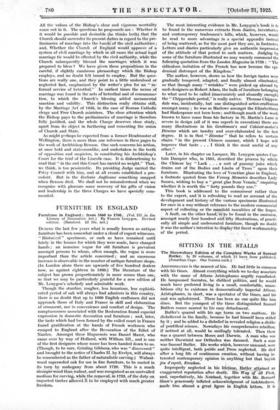FURNITURE IN ENGLAND
Furniture in England.:.. from 1660 to 176Q.: (Vol. do the
DURING the last few years what is usually known as antique furniture has been somewhat under a cloud of expert witnesses. " Historical " specimens, or such as have, remained until lately in the houses for which they were made, have changed hands ; an immense vogue for old furniture is prevalent amongst persons to whom, often enough, the vogue is more important than the article concerned ; and an enormous increase is observable in the number of antique furniture shops. (In London alone there are upwards of five hundred dealers now, as against eighteen in 1860.) The literature of the subject has grown proportionately in more senses than one, so that we may be particularly grateful for a new edition of Mr. Lenygon's scholarly and admirable work.
Though the sturdier, rougher, less luxurious, less sophisti- cated period of oak will always find admirers in this country, there is no doubt that up to 1660 English craftsmen did not approach those of Italy and France in skill and elaboration of ornament, nor in convenience and comfort of design. The sumptuousness associated with the Restoration found especial expression in domestic decoration and furniture ; and, later, the taste which had been formed by the exiled court in France found gratification at the hands of French workmen who escaped to England after the Revocation of the Edict of Nantes. Amongst these Huguenots was Daniel Marot, who came over by way of Holland, with William III., and is one of the first designers whose name has been handed down to us. (Though, to be sure, Grinling Gibbons, who was " discovered " and brought to the notice of Charles II. by Evelyn, will always be remembered as the father of naturalistic carving.) Walnut- wood superseded oak for use in fine furniture, to be ousted in its turn by mahogany from about 1720. This is a much Arcing" er-woOd than walnut, and was recognized as an unrivalled medium for carving, while the removal, in 1783, of the duty on imported timber alloWed it to be employed with much greater freedom.
The most interesting evidence in Mr. Lenygon's book is to be found in the numerous extracts from diaries, inventories, and contemporary tradesmen's bills, which, however, would be read to more advantage in a special appendix instead of being scattered; as for the most part they are, in footnotes. Letters and diaries particularly give an authentic impression of the attitude of that period to such matters. Judging by some of the furniture illustrated we may warmly commend the following quotation from the London Magazine in 1738: " The ridiculous imitation of the French has now become the epi- demical distemper of the Kingdom."
The author, however, shows us how the foreign tastes were gradually tempered, adapted, and finally almost eliminated, so that though many ". wrinkles " were picked up abroad by such designers as Robert Adam, the bulk of furniture belonging to what used to be called (inaccurately and absurdly enough) the " Chippendale period," is really native. Thomas Chippen- dale was, incidentally, but one distinguished artist-craftsman amongst many ; he was as Marlowe amongst the Elizabethans had Shakespeare not been born ; and though much of the work known to have come from his factory in St. Martin's Lane is severe in design (all of it was superb in execution) there are many illustrations in his Gentleman's and Cabinet-maker's Director which are tawdry and over-elaborated to the last degree. It is in that " Director" that he refers to certain chairs " in the present Chinese manner, which I hope will improve that taste . . . I think it the most useful of any other."
Later, in his chapter on Lacquer, Mr. Lenygon quotes Cap- tain Dampier who, in 1685, described the process by which the Chinese lay " Lack . . . a sort of gummy- juice which drains out of the Bodies and Limbs of Trees " upon their furniture. Illustrating the love of Venetian glass in England, a • footnote quoted from the •Verney Memoirs describes Lady Sussex, wishing to buy a " great glas from Vennis," enquiring whether it is worth the " forty pounds they axe."
This book is addressed to the connoisseur rather than to the expert, and it is refreshing to read an account of the development and history •.of the various specimens illustrated for once in a way without reference to the modern commercial aspect- of collecting or the manifold ram:sillies of the forger.
A fault, on the -other -hand,'•-ik* be found in the omission, amongst nearly foul- hundred anafifty illustrations, of practi- cally all simple and undecorated furniture, though no doubt it was the author's intention to diSplaythe finest workmanship of the period.






























































 Previous page
Previous page